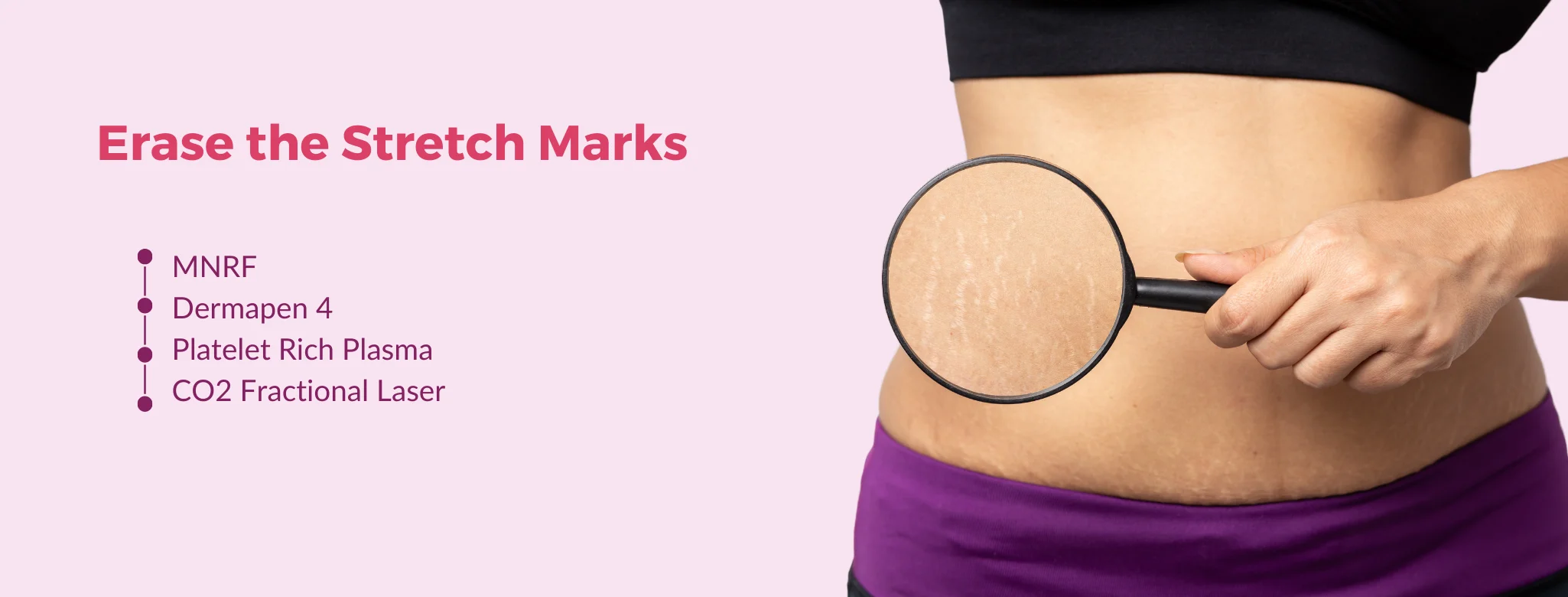
Stretch Mark Treatment Cost in Delhi
Stretch marks, also known as striae distensae, are elongated, narrow streaks
that develop on the skin as parallel lines, mainly present on the abdomen,
flanks, arms, breast and thighs.
These lines are a different colour and texture than your normal skin, and they
range from purple to bright pink to light gray.
On touching the stretch marks, they may feel slightly raised like a ridge, or
may be depressed forming an indentation on the skin.
Why do stretch marks occur?
A stretch mark is basically a scar which develops when our skin stretches or shrinks quickly. The abrupt change in the body size puts a stress on the collagen and elastin leading to their rupture. As the skin attempts to repair the damage, it results in scars called stretch marks.
Long term application of potent corticosteroid creams on your skin may also
result in stretch marks.
You have a higher risk of developing stretch marks if people in your family get
stretch marks!
Women have a greater tendency to develop stretch marks as compared with
males.
How do stretch marks look like?
In the initial stages, stretch marks may be red, purple, pink, reddish-brown, or
dark brown, depending on your skin colour. They may be slightly raised and
can be associated with itching.
In time, the colour fades and the narrow bands sink beneath your skin. On
maturity, stretch marks become depressed scars.
How can I get rid of stretch marks?
There are multiple ways in which stretch marks can be improved and made
less prominent.
It’s important to understand that no single treatment works for everyone.
Treatment options available include:
-
Creams, lotions, gels.
Use the product on early stretch marks.
Massage the product into your stretch marks
Apply the product every day for weeks.
- Chemical peels - stronger chemical peels are helpful in mild stretch marks
- Microdermabrasion - useful for improving very light striae.
- Laser - fractional ablative erbium:YAG or non - ablative erbium:glass, both give good results.
- Micro-needling with PRP - very effective, minimal down time, no side effects, cost effective treatment option even for severe stretch marks problem.
- Micro-needling with radiofrequency
How do Lasers and Micro-needling work to reduce Stretch marks?
They work on the principle of producing micro-injuries in the deeper layers of skin, thus stimulating new collagen formation and making the striae shallow and narrower with each subsequent sitting.
Are Laser or Micro-needling treatments for Stretch Marks a safe bet?
Yes, both the therapeutic options the best bet in terms of safety and efficacy on Indian skin. The biggest advantage of these treatments is the speed with which the results are achieved. You may notice an improvement after the first sitting itself.
Is the treatment painful?
The procedure is associated with slight discomfort but majorly tolerated well by most of the patients. For greater comfort, topical anaesthesia cream is applied for 30 minutes prior to the procedure. As an alternative, cold air or ice may be used to minimise discomfort.
Any side effects?
No serious side-effects or complications are noted post-treatment, however some redness and inflammation does occur over the treated area which is self-limiting and settles in 2-3 days. Ice compression may be done to reduce the discomfort.
How many treatment sessions will I need?
Stretch mark reduction requires 6 to 8 sittings done at interval of 4-6 weeks each.
Is the stretch mark removal permanent?
Yes, the stretch mark reduction is permanent.
Can anything prevent stretch marks?
No remedies have been discovered till date which may help in preventing the
stretch marks.
Nothing, like almond oil, cocoa butter, olive oil, or vitamin E, have been
shown to be useful as a preventive measure.
What Our Patients Say
Nothing gives us more pleasure than the happiness and gratitude expressed by our clients at the end of their Skin, Hair, and Laser treatment!

I recommend Dr. Shruti Gupta because she explains everything related to my problems patiently and p...
Divya Sonkar
Student
First of all I would like to thank Dr Shruti Gupta Mam for giving me a new life. On the advice of my...
Dinesh
DU Student
Dr.Shruti is very humble and adorable to everyone she explains everything wonderfully, and answers a...
Mukta Rathee
MBBS Student
It was a pleasant experience. Your work is par above my expectations. My exuberant hair growth gives...
Mohit Shukla
DJ
I have acne issue from last 13 year's I tried all from the to homemade solution but nothing's work a...
Sonal Wahi
SQ - CA25000 +
Happy Clients
5
Qualified Doctors
9
Luxury Suites
50 +
Authorized Partners

